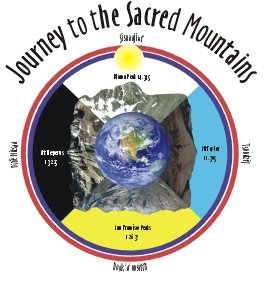Journey to the Sacred Mountains plans to revisit Hesperus Mountain on the weekend of July 17-18, 2010.
The route, via the Sharkstooth trailhead, is a moderate to strenuous 5 mile round trip hike. The trek includes a hike to the west ridge and then an arduous scramble up the steep scree riddled slop to the 13,234 ft summit.
Unless otherwise noted, we will be camping along the road to the trailhead on Saturday 7/17 and hiking early on Sunday 7/18. There are several possible camping spots along the last mile of the road approaching the trailhead. Look for the JTSM logo posted on a tree. There are no formal camping facilities or potable water sources in this area. The forest service recommends high clearance vehicles for the last several miles of the road.
Directions to the Sharkstooth Trailhead:
From the town of Mancos, turn north on Highway 184, continue .3 miles then turn right (east) onto West Mancos Road, also known as CR 42. Continue on the West Mancos Road for several miles; approximately two miles past the Transfer Recreation Area turn onto the Spruce Mill Road (NFSR #350). Travel another 6 miles, turn right onto NFSR #346, and continue another mile to the Sharkstooth Trailhead. Look for our base camp along this last 1 mile stretch.
Mr. Larry Archie Navajo Medicine Man is planning to join us. He will be making and Navajo offering and blessing at ~ 8 a.m. on Sunday. Contributions are welcome. The hike will begin following this service.
Based on traditional Navajo teachings, participants are asked be considerate of Sacred Mountains as follows:
Don’t use knife to cut anything living (vegetation, birds, animals)
Don’t have a bad thought
During the whole trip, no sexual relations
Don’t cut hair, nails, or beard while on the mountain
Not to have a party. No Alcohol. You’re on spiritual trip.
Sincerely, MountainsandMedicine
Journey to the Sacred Mountains is an at will activity. There are no fees. Mountaineering has inherent challenges. Weather and other conditions can be unpredictable. Individuals that choose to make all or part of this journey should carefully consider their experience, fitness, equipment, and personal health when considering climbing these mountains. Each individual is responsible for their own preparation, safety, equipment, sustenance, and shelter.
For all those that enjoy exploring the rugged Colorado lands, we highly recommend purchasing a Colorado Outdoor Recreation Search and Rescue (CORSAR) card. This helps fund search and rescue efforts in the state. Visit http://www.coloradosarboard.org/csrb-COSARFund.asp for more details.
Check this website for updates or email mountainsandmedicine@gmail.com.






